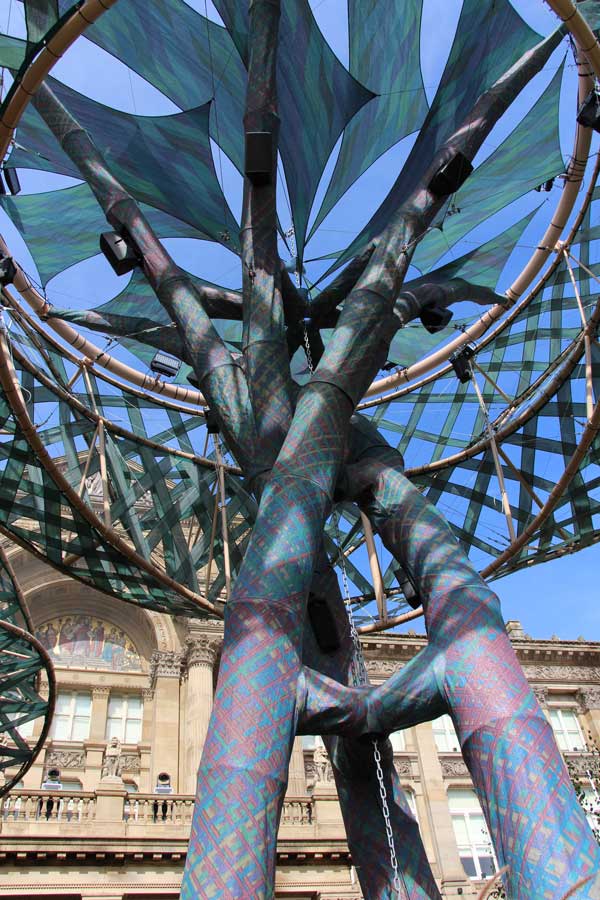Projects and Features
Steelwork branches out
The centrepiece for a spectacular city centre garden event was five fully-demountable and reusable steel-framed tree structures.
FACT FILE
PoliNations, Birmingham
Concept design team: Trigger, Carl Robertshaw Design, THISS Studio
Production team: Dock Street Events, Format Engineers
Steelwork contractor: S H Structures
Steel tonnage: 40t
For two weeks in September, Birmingham city centre hosted a pop-up garden featuring hundreds of plants and flowers, and five giant architectural steel trees that towered over the display.
Known as PoliNations, the garden was commissioned as part of UNBOXED: Creativity in the UK (a nationwide celebration of creativity that took place from March to October) and also presented as part of the Birmingham 2022 Festival.
PoliNations was produced and led by the Bristol based arts organisation Trigger, and a collective of creatives and experts in horticulture, arts, science, and architecture.
The end result was that Victoria Square was transformed into an urban oasis, hosting free events, workshops and performances including live music and dance.
The inspiration for the garden was to inform and educate people about the origins of well-known plants, highlighting the fact that around 80% of plants found in UK city gardens came from overseas.
“The idea was to create a forest within the garden display and the five steel trees did just that,” says Carl Robertshaw, who was part of the concept team. “People would generally look at the plants on the ground, but the trees had that Wow-factor and made visitors look up.”
During the initial design process a number of options were investigated, but steelwork was chosen as the material for the tree frames as it offered the most cost-effective and sustainable choice.
“We wanted the trees to be as lightweight as possible, but also robust enough to withstand quite high wind loadings, so steelwork was the best option,” explains Dock Street Events’ Technical Director Chris Clay.
Reusability was another key requirement as the concept design team always envisaged the tree structures being used again at future events, either individually or as a group of five. To fulfil this precondition, the structures have a series of bolted connections that allows them to be erected and disassembled numerous times.
“Four of the trees are 11m-tall and identical, while the fifth, known as the mother tree is 12m-tall and has three extra extension trunk members. Other than that, all the steelwork is the same and theoretically the steelwork is inter-changeable and could fit any of the trees,” explains S H Structures (SHS) Project Manager Rob Binks.
As the trees were, and probably will be again in the future, erected on a public space, no foundations could be installed. Consequently, they were founded and supported on triangular steel base plates, 6m long on each side, that incorporate approximately 16t of concrete ballast each.
Bolted on to the base plates, the tree steelwork forms a cocktail glass shape, consisting of three complex twisting trunks that diverge into six branches near the top, which in turn support an uppermost 8m-diameter ring.
The twisting shape of three trunks is formed with facetted CHS members, using 355mm-diameter sections for the lowest parts. The CHS members, which are generally up to 3m long, sequentially decrease in size as they go up the structure, with the branches formed with 219mm-diameter sections. Adding some stability to the structures, the trunks are tied together at three points within their height.
Supported by the six branches, the ring creates the uppermost canopy part of each tree structure. The ring is also fabricated from tubular steelwork and is formed with six 219mm-diameter CHS sections.
Highlighting the ease with which the trees can be erected and then taken down, it took the erection team approximately one week to install trees and the same amount of time to disassemble them at the end of the two-week event.
Getting the trees erected quickly was an important requirement, as after each structure was fully assembled, a whole range of follow-on trades were waiting to start their work.
Once handed over, the tree steelwork had a series of lights fixed to it and then they were clad with a mesh fabric. The lights shine through the cladding during night-time performances, while the mesh also hides the bolted connections and gives the structures a more tree-like appearance.
Meanwhile, at the top of the structures, the canopy ring works very hard as numerous items are hung from it. This includes five pringle-shaped aluminium rings that are bound together with the same mesh cladding to form framework’s that resemble foliage.
The canopy ring also supports speakers for the music part of the event’s sound and light shows.
For peace of mind and before arriving on site, steelwork contractor S H Structures trial erected each tree to make sure they fitted together perfectly. A further trial, using one tree, was then carried out using all of the other elements, such as the aluminium rings and cladding.
All of the trees are now packed away in containers, awaiting their next event, when SHS will be called upon to use its expertise to erect and take them down again.
Summing up, Format Engineers Director James Solly says: “Structural steel was the logical choice as it combined the strength needed to support the huge feature canopies under high winds, while achieving the slimness of profile needed to accentuate the tall slender tree-like structures.
“Alternative materials were considered but rejected in favour of steel as this had good dynamic performance, ease of erection and low embodied energy via the extensive use of repurposed section profiles sourced from Cleveland Steel & Tubes.”

















